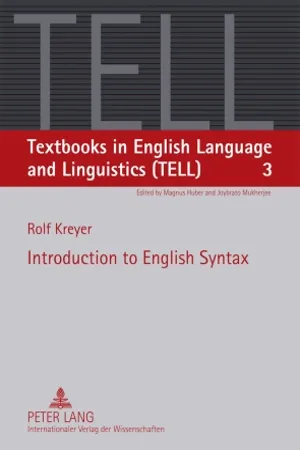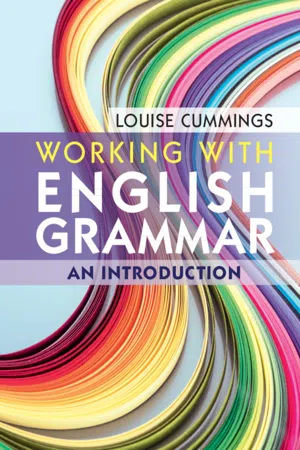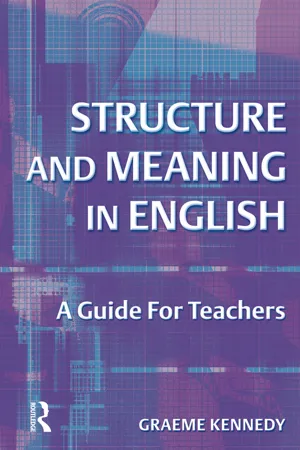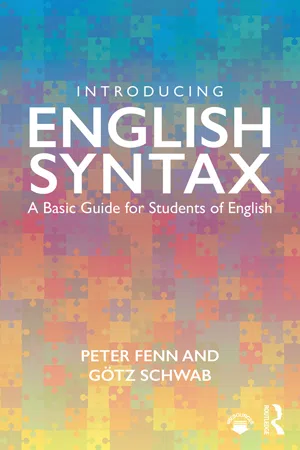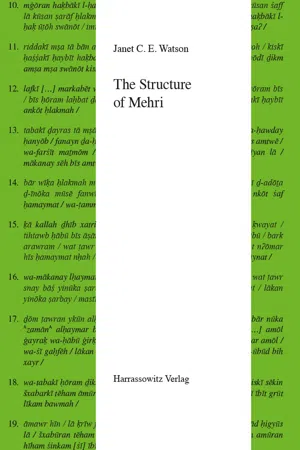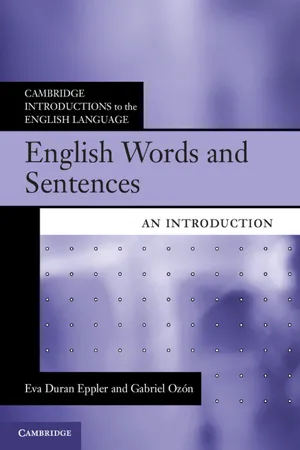Languages & Linguistics
Adverb Phrase
An adverb phrase is a group of words that functions as an adverb in a sentence. It typically consists of an adverb and other words that modify or complement it. Adverb phrases can provide information about time, place, manner, degree, or frequency, and they play a crucial role in adding detail and nuance to the meaning of a sentence.
Written by Perlego with AI-assistance
Related key terms
1 of 5
6 Key excerpts on "Adverb Phrase"
- eBook - PDF
- Rolf Kreyer, Joybrato Mukherjee(Authors)
- 2012(Publication Date)
5 Adjective, Adverb and Prepositional Phrase The two previous chapters dealt with the most important phrases of the English language, the verb and the noun phrase. This chapter will give a short overview of the three remaining phrases, namely adjective, adverb and prepositional phrase. 5.1 The adjective phrase Like the noun phrase, the adjective phrase can be defined with regard to its head, i.e. an adjective phrase is a phrase the head of which is an adjective. The adjec- tive phrase is similar to the noun phrase in that it contains premodifiers and postmodifiers. It differs from the noun phrase in that it does not contain deter- miners. The basic structure of the adjective phrase, accordingly is 'premodifica- tion - head - postmodification', consider the examples under (1) (the head is in bold print): (1) a) more traditional (w1a-012:043) b) almost impossible (w2b-016:067) c) hugely unprofitable (w2b-016:048) d) very restricted (s1a-001:104) e) far more simple (s2a-034:050) f) bigger than that (s1a-001:054) g) aware of how they can work with the disabled stu- dent (s1a-001:110) h) uninterested in conquering and controlling Fiji (w1a-012:010) i) unlikely to appreciate the irony of their situation (w2e-008:002) j) much cheaper than anybody else (s1a-010:036) k) very surprised at their commitment (s1a-005:157) l) quite happy to send their daughter to a boys' school (s1a-012:223) m) far too late for tinkering with the environment (w2b-013:004) As can be seen, adjectives (in addition to occurring on their own) can be pre- modified, postmodified or both. Aarts and Aarts (1982: 67) point to two special classes of adjectives. The first are adjectives that never occur with a modifier. 90 Chapter 5 Examples are latter in the latter view (w2a-006:081) or former in the former chief of defence staff (s2a-019:022). Such adjectives only occur as noun-phrase premodifiers, i.e. in attributive but never in predicative function (see section 2.2.4). - eBook - PDF
Working with English Grammar
An Introduction
- Louise Cummings(Author)
- 2018(Publication Date)
- Cambridge University Press(Publisher)
He moves quite [Adjunct] gracefully [Head] for a man [Complement]. The main points in this section are summarised below. 5.6 Prepositional Phrases The final type of phrase we need to examine is the prepositional phrase. As one might expect by this stage, a prepositional phrase consists of a head preposition and its modifiers. However, we must already note a feature which sets preposi- tional phrases apart from other phrases. Whereas in other phrases the head can stand on its own without modifiers, this is not possible in a prepositional phrase. This is because a preposition which occurs on its own results in an ungrammatical sentence: The house is next to the lake. [Prepositional phrase] *The house is next to. They live in Portugal during the winter. [Prepositional phrase] *They live in Portugal during. We merely note this feature of prepositional phrases, but continue to describe prepo- sitions as the head of prepositional phrases in exactly the same way that we describe nouns and verbs as the heads of noun phrases and verb phrases, respectively. The following sentences each contain a prepositional phrase. These sentences illustrate that, like Adverb Phrases, prepositional phrases can occupy a range of positions in the sentence. This includes sentence-initial and sentence-final KEY POINTS Adverb PhraseS • An Adverb Phrase is a head adverb and its modifiers. An adverb on its own without a pre- modifier or a post-modifier is also an Adverb Phrase. • An adverb can be a pre-modifier in an Adverb Phrase (really quickly, quite stupidly). The only possible post-modifier in an Adverb Phrase is a prepositional phrase (effortlessly for an amateur). • Adverb Phrases can be pre-modifiers and post-modifiers in other phrases. They can be pre-modifiers in adjective phrases (quite unbelievably stupid) and post-modifiers in verb phrases (sings rather beautifully). • Adverb Phrases can occupy a range of positions in the sentence. - eBook - ePub
Structure and Meaning in English
A Guide for Teachers
- Graeme Kennedy(Author)
- 2014(Publication Date)
- Routledge(Publisher)
Chapter 6 Modification of noun phrases, verb phrases and sentencesThis chapter is designed to show how adjectives, adverbials and prepositions are used, and the difficulties that learners of English are faced with in using them.Objectives By the end of this chapter you should be able to:6.1 Adjectives- Identify adjectives.
- Explain the functions of adjectives.
- Identify the various forms of adjectives.
- Describe the positions adjectives are found in.
- Explain the functions of comparative and superlative adjective and adverb forms.
- Distinguish adjectives from participles.
- Identify adverbs and adverbials.
- Distinguish adjectives from adverbs.
- Describe the main structures that can be used as adverbials.
- Explain the main semantic functions of adverbials.
- Distinguish between adjuncts, subjuncts, disjuncts and conjuncts.
- Identify prepositions.
- Explain the main functions of prepositions and prepositional phrases.
- Know which prepositions are most frequently used.
- Distinguish between prepositional verbs and phrasal verbs.
We have already seen in Chapter 4 that determiners can modify nouns. Nouns can also be modified in other ways as part of noun phrases, e.g.1 a successful athlete2 an outstanding athlete3 an athlete from Spain4 an athlete who was successful in the Olympics5 an athlete known all over the worldThese five examples show that nouns can be modified by single words, phrases, or whole clauses. Some modifiers occur before the nouns they modify; others occur after. One of the classes of noun modifiers consists of single words called adjectives which associate certain characteristics such as colour, size or shape to nouns, e.g. a red car. This section describes the use of adjectives. The modification of nouns by phrases or clauses is described in Chapter 7 - eBook - ePub
Introducing English Syntax
A Basic Guide for Students of English
- Peter Fenn, Götz Schwab(Authors)
- 2017(Publication Date)
- Routledge(Publisher)
There is an important difference, though. In (58)a. the prepositional phrase is closely related to the adjective in sense, and cannot be moved independently to another part of the sentence. In (58)b., on the other hand, the prepositional phrase relates to the sentence as a whole, and functions as an independent adverbial. A functional analysis of the sentence shows the difference:p.89We now want to see how the Adverb Phrase fits into larger phrase patterns, for example within an adjective phrase inside a noun phrase. Here a diagram of the noun phrase the quite hotly spiced curries of Sri Lanka:4.4.1 Adverbs in strange places: some special casesAdverbs of place and time have their own particular kinds of degree adverb, with which they usually form fairly restricted collocations: right behind , well ahead , close by , far away ; just then , right now , etc. Though they may not look like it, these are structurally and functionally quite normal Adverb Phrases, with the second adverb as the head and the first as the premodification.p.90Adverbs of place and direction can themselves act as premodifiers, not as degree adverbs, but as a kind of what we might call ‘specifier’, giving more semantic exactness to common generalised place adverbs like here and there . The premodifier in this case is usually an adverb particle (see 1.3.5 and 5.1): over here , up there , out there , down here . But there are also combinations with prepositions: through here , along there , from here , until later , by now , since then . These must be seen as prepositional phrases, with the adverb as prepositional complement (see also 3.2):As mentioned briefly in 4.2.1, prepositional phrases can also have adverb particles as a kind of ‘specifying’ premodification: up in Scotland , over in France , down in the south :p.91 Note that we need the head phrase slot here because the adverb premodifies the whole prepositional phrase, i.e. in the form(63) [up [(in) Scotland]]Mentioned at the beginning of this section above were particular kinds of degree adverb premodifying adverbs of place and time. Quite logically, they can also premodify prepositional phrases (since prepositional phrases are also adverbial in function): just behind the door , right outside the bank , shortly after midnight (see also 4.2.1). The phrase patterning is that of (62). Certain degree adverbs focus specifically on numerals and quantifiers: about fifty students , almost all children , practically every pupil - eBook - PDF
- Janet C. E. Watson(Author)
- 2014(Publication Date)
- Harrassowitz Verlag(Publisher)
9 Supplementation Adverbs modify adjectives, verbs, clauses and other adverbs. Adverbs and adverbials differ syntactically from complements in that they are supplementary and are not required to complete the proposition, they are less tightly bound to the modified element than complements, and many adverbs are not restricted to a particular position in relation to the modified element. In Mehri, there are a few words and particles that function solely as adverbs (cf. 2.8). These include some adverbs of time and degree ending in -an , -a ( h ) or -ō h , such as ḥā w ē lan ‘earlier’, ī m ō h ‘today’, n ṣ ar ō mah ( ṣ ar ō mah ) ‘now’, w ī yan ~ w ī ya ‘very; much’; 1 adverbial particles such as b ā r , ʕā d ( ā d ) and ā r ; and interrogative adverbs such as mayt ( an ) ‘when’, h ī b ō h ‘how’, kam ‘how much, how many’, wk ō h ‘why, how’. In particular contexts, NPs and, more commonly PPs, function adverbially. Adverbial clauses are introduced by adjunctions, by wa - in the case of circumstantial clauses, or paratactically. In this chapter, I examine the syntax of adverbs and adverbial phrases within simplex clauses and then the syntax of adverbial clauses. 9.1 Adverbs 9.1.1 Adverbs of time The largest number of adverbs come under the category of adverbs of time. Adverbs of time can be subcategorised into those denoting a point or period in time, such as ‘in the morning’, ‘last year’, those denoting a boundary in time before or after which an event or state occurred, such as ‘afterwards’, ‘beforehand’, those denoting the duration of a state or event, such as ‘for two days’, ‘a whole year’, and those denoting the frequency of an event, such as ‘once’, ‘never’ (cf. Quirk & Greenbaum 1973: 229–230). They include the specific adverbs listed in chapter 2 (tables 81, 82), and adverbial phrases formed from PPs and NPs relating to time, such as the time and days of the week. - eBook - PDF
English Words and Sentences
An Introduction
- Eva Duran Eppler, Gabriel Ozón(Authors)
- 2012(Publication Date)
- Cambridge University Press(Publisher)
You may run out of patience before you arrive at a full answer, because combining all English degree adverbs with all English adverbs is a very tedious task. And by the time you think you are done, somebody may have created / invented a new adverb by adding -ly to another word. The good news is that this new adverb will behave (morpho-syntactically) just like all other adverbs. So while language is creative, it tends to be creative within the boundaries of its own parameters, i.e. its grammar. 5.6 Chapter summary In this chapter we looked at the morpho-syntactic relations words enter with other words to – eventually – create sentence and text meaning. In spoken and written language use, words form groups or phrases; one word in a group (the head) plays the most important role in terms of meaning and Activity 5.11 In the sentence I cycle very slowly to Covent Garden 1. Which word is slowly related to? 2. Is the other word obligatory or optional? 3. Does the word stand before or after it? 4. Which of the two words is dominant? 5. Do the answers to questions 1 to 4 hold true for most / all cases of this syntactic relation? Chapter 5, section [5.6] 96 grammatical properties. Phrases are named after this head word. We then looked at how nouns, adjectives, adverbs and prepositions combine with other words and came to the conclusion that words from the same word class behave similarly with respect to their dependents. Finally we arrived at a set of five questions which gets us quite a long way in any morpho-syntactic analysis. These questions are 1. Which word(s) does the word we are looking at enter into semantic and morpho-syntactic relations with? 2. Are these relations obligatory or optional? 3. Are they pre- or post-modifying relations? 4. Which of the two words is the head? 5. Is this syntactic relation productive / generative? Key terms Phrase; head; dependent; pre-modifier; post-modifier; apposition.
Index pages curate the most relevant extracts from our library of academic textbooks. They’ve been created using an in-house natural language model (NLM), each adding context and meaning to key research topics.
